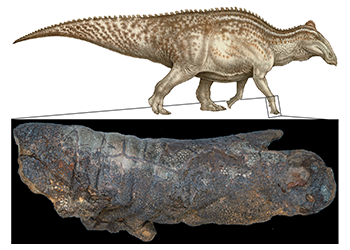Dinosaur Mummy Provides New Insight into Soft Tissue Fossilization
News

Dinosaur Mummy Provides New Insight into Soft Tissue Fossilization
In 2008, an Edmontosaurus “mummy” arrived at the North Dakota Geological Survey where lab technicians began the process of removing sediment and preparing the specimen for paleontologists to investigate. Nicknamed “Dakota,” the mummy revealed several unexpected features, such as extensive areas of fossilized skin and the presence of a broad fingernail on the end of dinosaur’s ‘mitten-like’ hand.
A paper published in PLOS reveals that these bite and potential claw marks in its beautifully preserved skin defied paleontological conventions on how such fossils formed.
“Conventional wisdom was telling us that ‘Dakota’ shouldn’t exist,” said Stephanie Drumheller, lead author and paleontologist at the University of Tennessee, Knoxville. “We needed to figure out how dinosaur skin, which had clearly been partially eaten, still managed to survive long enough to be buried and fossilized.”
Traditional understanding was that very rapid burial after death was necessary for soft tissue to end up in the fossil record. Burial is a great way to slow down many of the processes that break down remains, including predation and scavenging.

“Dinosaur mummies, however, never fit very well in this model,” Drumheller said. “They often appeared dried out, as if they had been baking under the sun for some time.”
In addition, long-term exposure would also leave the remains vulnerable to scavenging, which was thought to destroy any chance for the soft tissues to fossilize.
Fortunately, the field of forensic anthropology provided an alternate explanation. Modern research into patterns of decomposition suggests that partial scavenging of a carcass can, somewhat unintuitively, help dry and preserve skin over longer periods of time, even when the other soft tissues have decayed.
Researchers took digital images of the inside of “Dakota” that revealed the skeleton was preserved with the empty skin deflated around and appressed to the bones. All of the other internal organs were missing, which meant the dinosaur’s carcass could have laid on the landscape for weeks to months before burial – plenty of time for the organs and muscles to be eaten or decompose and for the skin to dry out and deflate before it was buried in sand.
“Not only has ‘Dakota’ taught us that durable soft tissues like skin can be preserved on partially scavenged carcasses, but these soft tissues can also provide a unique source of information about the other animals that interacted with a carcass after death, said Clint Boyd, Senior Paleontologist at the North Dakota Geological Survey.

Uncovering the Past
When “Dakota” arrived at the North Dakota Geological Survey, much of it was hidden under rock. For years, lab technicians removed sediment concealing the preserved skin, which revealed several unexpected features.
“Preparation of the skin itself is a time-consuming, delicate task,” said Becky Barnes, lab manager at the North Dakota Geological Survey. “You already know you’re working on something amazing, but then you begin seeing wrinkles and folds from a time before the animal became a fossil – it really brings the living-breathing creature into focus.”
Preparation also revealed deep gouges and punctures in the dinosaur’s skin that looked like evidence of predator activity. Some of the damage was caused by extinct crocodile-relatives, and some looked more consistent with a dinosaurian predator, such as the Hell Creek’s most famous resident: T. Rex.
“While you’re removing rock from the skin, sometimes you’d uncover these peculiar areas where the scales just weren’t there,” said Mindy Householder, fossil preparator at the North Dakota Geological Survey. “At first, you’re thinking it is a bit odd that the skin didn’t preserve there. After you’ve uncovered a few of them though, you start to notice a pattern and realize there’s something else going on here – these are tooth punctures.”
Read more about “Dakota” and what researchers discovered about the mummified dinosaur online at PLOS.
Photo credits
Line drawing art credit – Becky Barnes
Full color Edmontosaurus reconstruction – Natee Puttapipat
